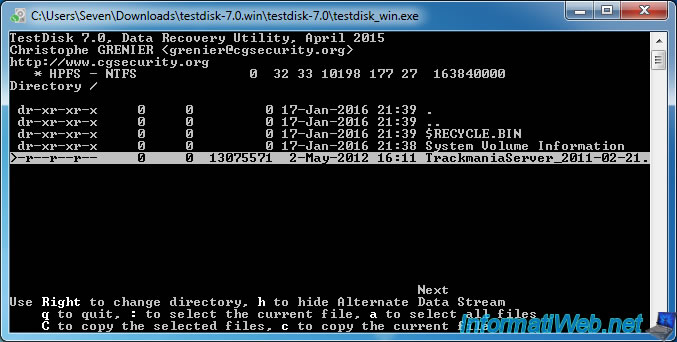
In Windows, you could do the same by opening Command Prompt as an administrator and using the bcdedit command exactly like this: Bcdedit /set /addfirst In Ubuntu, you can do it with the efibootmgr command. That's easy: you'll just need to move "Windows Boot Manager" to be the first item in the boot order.
#Boot testdisk windows#
Your secondary goal would be to fix the Windows boot.

#Boot testdisk install#
If there is enough space for it, your goal might be to create another ESP on the Ubuntu installation target USB, and install the Ubuntu bootloader there. To find out if that's true, you might boot from the live USB drive again, and then examine the contents of the other USB drive. Since your Windows is not overwritten and you stated your goal was to install Ubuntu on the external USB, I'd assume that your Ubuntu installation ended up there just as you ordered, except for the bootloader. You might not have created an EFI System Partition (ESP for short) on the external USB, so the ESP in sda2 was the only valid location for installing an UEFI bootloader. And if you're trying to boot with the external USB disconnected, GRUB is getting confused as its configuration and/or some of its modules are located in the (now-unreachable) external USB. Or should I just give up and reinstall everything or is there still some hope?įrom your description, it seems likely that you managed to install Ubuntu on your external USB disk just fine, but GRUB, Ubuntu's bootloader, got installed into sda2, your EFI System Partition. Should I just try to change that partition characteristics from D=deleted to P=primary?Īre there any other partitions I should recover? When I try to visualize file in many of them (like the preceding one) I only get this message: Can't open filesystem.
#Boot testdisk full#
Here is the full log (note that I ran the deep search twice). I checked some of them with P, which allows me to see the files contained in each. In the following screen I get a list of partitions (or at least I think they are). The following partitions can't be recovered: The harddisk (256 GB / 238 GiB) seems too small! (< 12 TB / 11 TiB)Ĭheck the harddisk size: HD jumpers settings, BIOS detection. Here is the result TestDisk 7.0, Data Recovery Utility, April 2015ĭisk /dev/sda - 256 GB / 238 GiB - CHS 31130 255 63

Welcome to GNU Parted! Type 'help' to view a list of commands.ģ) testdisk: first level analysis could not find any partition, so I did the deeper search. Parted could not see the partition with my ubuntu installation so I tried to rescue starting from +1 sector after the fourth partition but to no result: sudo parted Number Start End Size File system Name Flagsġ 2048s 1023999s 1021952s ntfs Basic data partition hidden, diagĢ 1024000s 1228799s 204800s fat32 EFI system partition boot, espģ 1228800s 1261567s 32768s Microsoft reserved partition msftresĤ 1261568s 89327144s 88065577s ntfs Basic data partition msftdata Sector size (logical/physical): 512B/512B This is the output of the repair process.Ģ) parted sudo parted /dev/sda unit s print What I triedġ) I tried boot repair but the problem persists. I can still boot into Windows by selecting it in the boot manager but if I do nothing the computer goes into GRUB. After removing both USB sticks I tried to boot into my primary Ubuntu installation (that of my laptops internal hard drive) but now the laptop boots into GRUB 2.2 (with “Minimal BASH-like editing supported”) rather than into Ubuntu. When the installation finished, I removed the drive and rebooted. I took two drives, installed the live version of ubuntu 18.10 on the first, booted into it, and then used the installer to install ubuntu on the second usb.

I wanted to install Ubuntu on an external usb drive.
#Boot testdisk windows 10#
Dell Chromebook 13 with Windows 10 and Ubuntu 18.10 on dual boot, using MrChromebox UEFI Firmware (4.9).


 0 kommentar(er)
0 kommentar(er)
